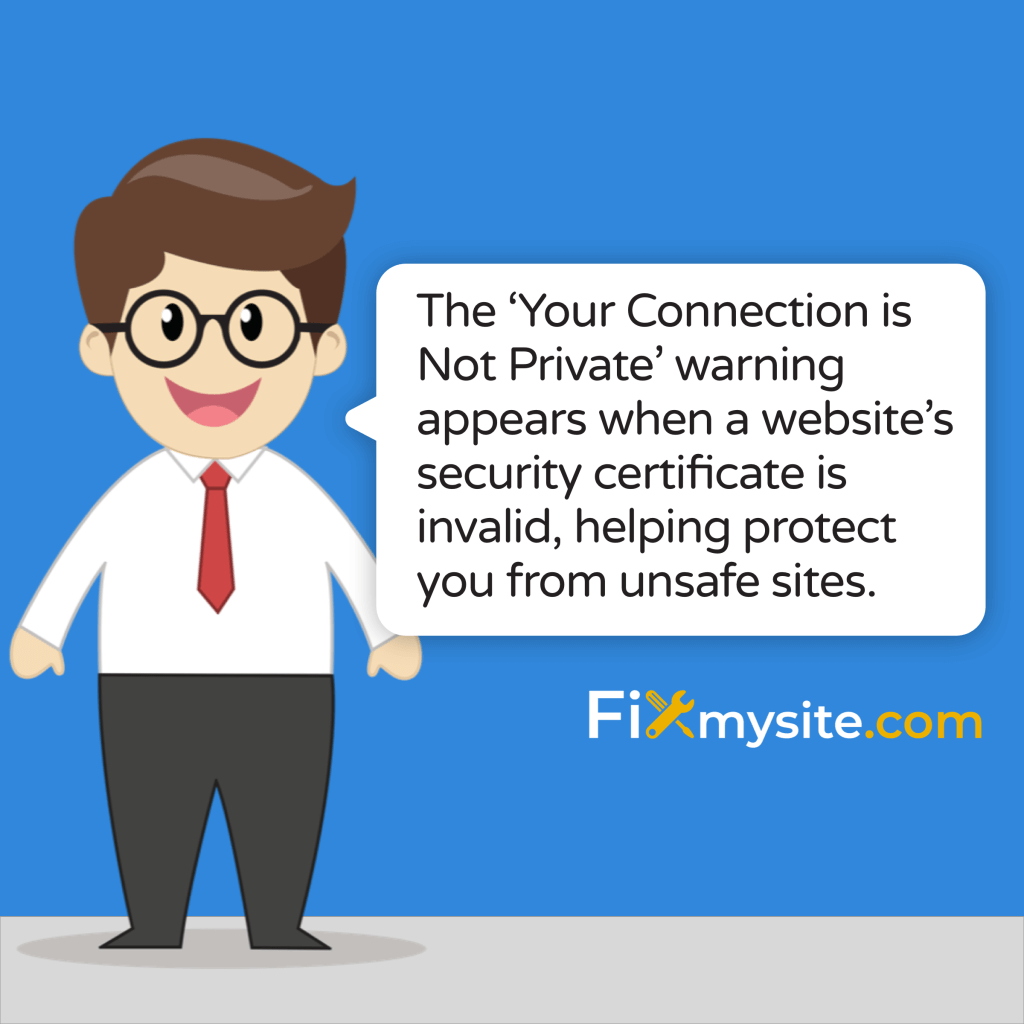
Seeing the “Your Connection is Not Private” error can be frustrating. This browser warning appears when there’s a problem with a website’s security certificate. It protects you from potentially unsafe websites. Let’s explore how to fix this common issue.
This error message varies slightly between browsers but always indicates the same problem. Your browser detected security issues with the website’s SSL certificate. This protection helps keep your personal information safe when browsing.
We understand how stressful these warnings can be, especially for business websites. The good news is that most connection privacy errors have simple solutions. This guide will walk you through each potential fix step by step.
Understanding the ‘Your Connection is Not Private’ Error
The “Your Connection is Not Private” error is a security warning. It appears when your browser cannot verify a secure connection to a website. This protection helps prevent potential data theft. Security matters more than ever online.
Browsers block sites with invalid certificates to prevent unencrypted data transmission. (Source: Kinsta) This security measure protects your personal information. It stops potential attackers from intercepting sensitive data.
Think of this error as your browser’s security guard. It stands between you and websites with potential security issues. The warning helps you make informed decisions about proceeding. Your data safety remains the priority.
What This Error Actually Means
This error indicates a problem with the SSL/TLS certificate. SSL certificates create encrypted connections between browsers and websites. They verify a site’s identity and protect data in transit. Valid certificates build trust with visitors.
When you see this warning, your browser detected certificate problems. These might include expiration, misconfiguration, or domain mismatches. The browser blocks the connection to protect your information. Safety comes first.
While alarming, this error doesn’t always mean the site is dangerous. Often, it’s a technical issue with the site’s security configuration. Understanding the specific cause helps find the right solution. Let’s examine each possibility.
How Browser Security Protections Work
Browsers verify website security through SSL/TLS certificates. These digital certificates authenticate website identity and enable encryption. The verification process happens in milliseconds. Your browser handles this automatically.
The security check involves multiple verification steps. Your browser validates the certificate against trusted authorities. It checks expiration dates and ensures proper configuration. Any issues trigger the privacy warning.
This protection prevents “man-in-the-middle” attacks. Without it, attackers could potentially intercept your data. The privacy error might seem inconvenient but serves an important purpose. It protects your personal information.
Different Browser Variations of the Same Error
Each browser displays this security warning differently. Chrome shows “Your connection is not private.” Firefox users see “Warning: Potential Security Risk Ahead.” Safari displays “This Connection Is Not Private.” The meaning remains the same.
Let’s look at how different browsers present this same security concern:
| Browser | Error Message | Error Code |
|---|---|---|
| Google Chrome | Your connection is not private | NET::ERR_CERT_DATE_INVALID |
| Mozilla Firefox | Warning: Potential Security Risk Ahead | SEC_ERROR_EXPIRED_CERTIFICATE |
| Apple Safari | This Connection Is Not Private | Safari can’t verify the identity of the website |
| Microsoft Edge | Your connection isn’t private | NET::ERR_CERT_AUTHORITY_INVALID |
Despite different wording, all these messages indicate the same issue. The browser cannot verify the website’s security certificate. The underlying problem requires the same troubleshooting steps. Let’s explore those solutions.
Common Causes of the Privacy Error
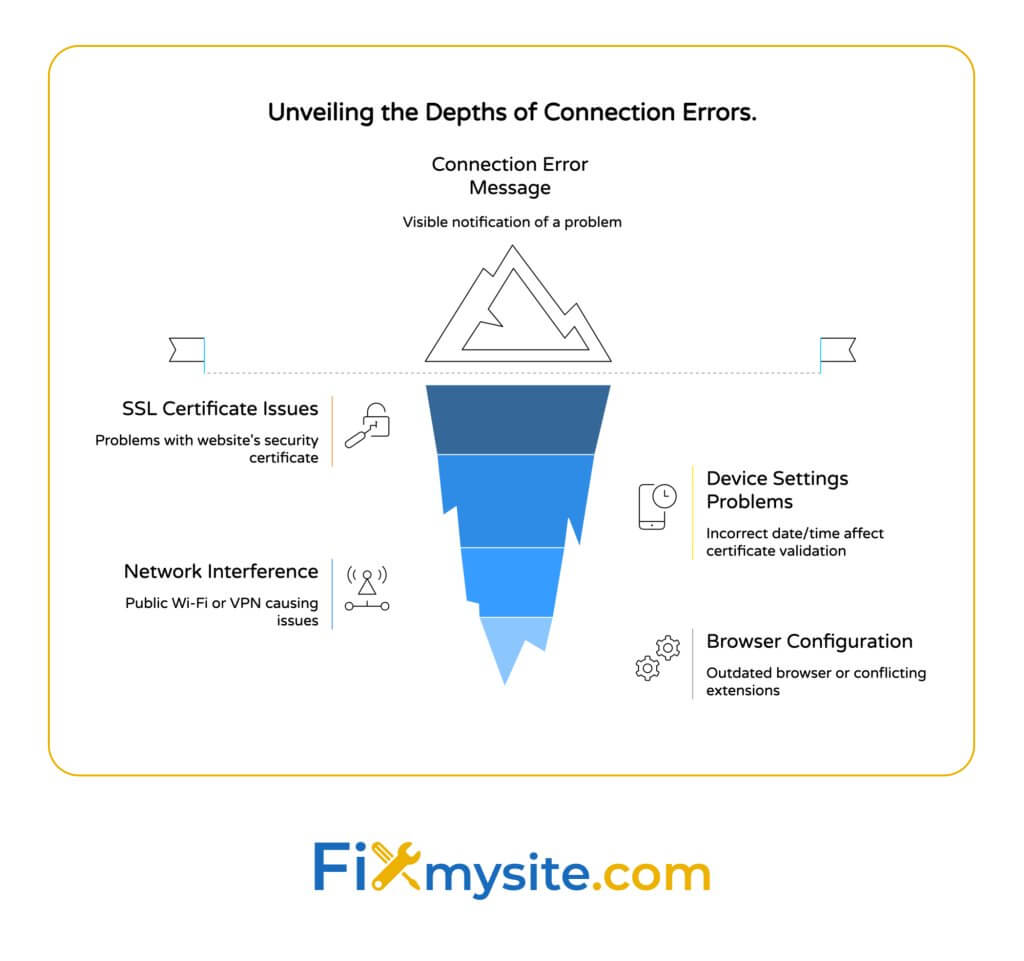
Several factors can trigger this privacy warning. Identifying the specific cause helps find the right solution. Most issues fall into a few common categories. Let’s examine each one.
Understanding why this error appears helps solve it faster. The error might stem from your device, the website, or your network. Knowing the source points to the correct fix. Most causes have straightforward solutions.
Expired or Invalid SSL Certificates
SSL certificates have expiration dates for security reasons. When a certificate expires, browsers show the privacy warning. Website owners must renew certificates before they expire. Timely renewal prevents these errors.
Incorrect certificate installation also triggers this error. Server misconfigurations like domain mismatches cause certificate validation failures. (Source: Kinsta) These technical issues require action from the website administrator.
For website visitors, these certificate problems are beyond your control. You’ll need to try the troubleshooting steps in the next sections. For site owners, certificate renewal and proper installation are essential.
Incorrect Date and Time Settings
Your device’s date and time settings affect certificate validation. Certificates contain validity periods with specific dates. If your system date is incorrect, validation fails. This causes privacy warnings even on secure sites.
Incorrect date/time settings disrupt certificate expiry checks, triggering security warnings. (Source: Domain.com) This simple issue has an easy fix. Updating your system time resolves the problem.
This problem commonly affects devices after battery replacement or time zone changes. Check your system date and time if you suddenly see multiple privacy errors. Synchronizing with internet time servers helps maintain accuracy.
Network Interference Issues
Sometimes network configurations interfere with secure connections. Public Wi-Fi networks often implement security measures that affect browsing. These measures can inadvertently trigger privacy warnings. Alternative connections help diagnose this issue.
Security tools sometimes block valid certificates, causing unnecessary warnings. (Source: Domain.com) VPNs, proxies, and antivirus software can all interfere with certificate validation. Temporarily disabling these tools helps identify interference.
Corporate networks may use SSL inspection for security monitoring. This technique can cause privacy errors on personal devices. Contact your network administrator if you suspect this situation. They can provide specific guidance.
Public Wi-Fi Connection Problems
Public Wi-Fi presents unique security challenges. Many public networks require login through a captive portal. This can trigger connection privacy errors before proper authentication. Try accessing the portal directly.
Unsecured networks increase exposure to attacks, prompting warnings even on legitimate sites. (Source: Domain.com) Public Wi-Fi security varies widely in implementation. Some configurations interfere with normal certificate validation.
For better security on public networks, consider using a VPN. VPNs add encryption layers to mitigate risks on public Wi-Fi. (Source: Domain.com) This extra protection helps maintain privacy on untrusted networks.
Antivirus or Firewall Interference
Security software often includes web protection features. These features scan encrypted connections for threats. This scanning process can interfere with normal certificate validation. It triggers privacy warnings.
Some antivirus programs replace website certificates with their own. This allows them to inspect encrypted traffic. While intended for protection, it can cause certificate errors. Temporarily disabling these features helps diagnosis.
Here’s a quick reference for which solutions match each cause:
| Common Cause | Primary Solution | Alternative Solution |
|---|---|---|
| Expired/Invalid SSL Certificate | Contact website owner | Try alternative websites |
| Incorrect Date/Time Settings | Update system date and time | Sync with internet time server |
| Network Interference | Try different network | Disable VPN temporarily |
| Public Wi-Fi Issues | Connect to captive portal | Use mobile data instead |
| Antivirus Interference | Temporarily disable web shield | Add exception for the website |
Now that we understand the causes, let’s look at specific solutions. The following sections provide step-by-step fixes. Try them in order for best results.
Quick Fixes for ‘Your Connection is Not Private’ Error
Let’s start with simple solutions. Many privacy errors resolve with basic troubleshooting. These quick fixes solve most cases. Try each one in sequence.
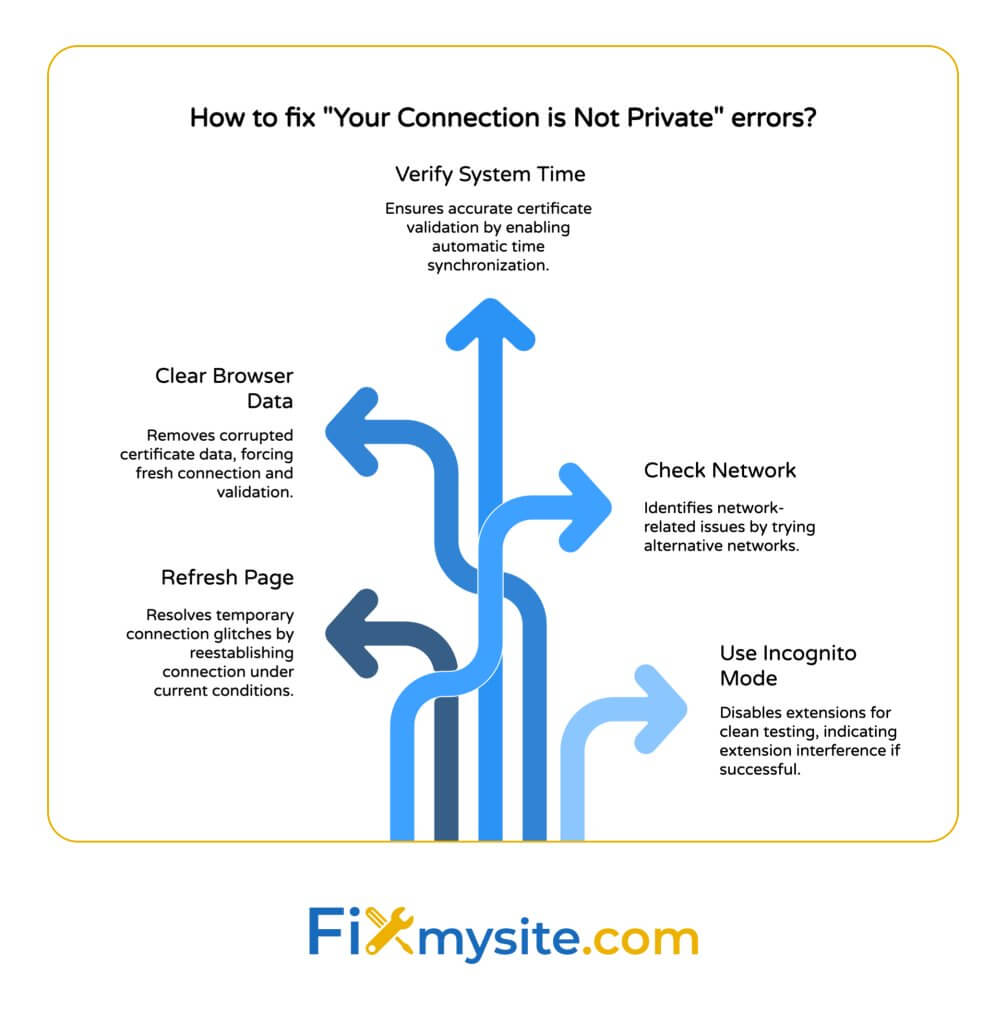
These solutions require no technical expertise. They work across all major browsers and operating systems. Most take less than a minute to implement. Let’s begin with the simplest approach.
Refresh the Page
Sometimes, the simplest solution works best. Temporary glitches often resolve with a reload. (Source: Avast) Press F5 or click the refresh button. This often clears temporary connection issues.
Network conditions change constantly, especially on wireless connections. A momentary interruption might trigger the error. Refreshing re-establishes the connection under current conditions. This often resolves the warning.
If the site uses multiple servers, refreshing might connect you to a different server. This server might have properly configured certificates. Wait a few minutes before trying if the first refresh doesn’t work.
Clear Browser Cache and Cookies
Browsers store website data to improve loading speed. Sometimes this cached data conflicts with current security settings. Clearing cache removes potentially corrupted data. This forces a fresh connection.
Corrupted data might interfere with certificate validation, causing unnecessary warnings. (Source: Google Support) Clearing your browser cache eliminates this possibility. The process varies slightly between browsers.
Here’s how to clear cache in major browsers:
- Chrome: Settings > Privacy and security > Clear browsing data
- Firefox: Settings > Privacy & Security > Cookies and Site Data > Clear Data
- Safari: Preferences > Advanced > Show Develop menu > Develop > Empty Caches
- Edge: Settings > Privacy, search, and services > Clear browsing data
After clearing cache, close and reopen your browser. Then try accessing the website again. This fresh start often resolves certificate validation issues. The site should load normally.
Verify System Date and Time
Certificate validation depends on accurate system time. An incorrect date or time causes validation failures. Check your device’s clock settings. They should match your current time zone.
Incorrect date/time settings disrupt certificate expiry checks, causing unnecessary warnings. (Source: Domain.com) Fixing your system clock often resolves these errors immediately. The setting location varies by operating system.
For best results, enable automatic time synchronization. This keeps your clock accurate without manual adjustment. Most operating systems include this feature. It prevents future certificate validation problems.
Check Network Settings
Network configuration can affect secure connections. Public Wi-Fi networks often have special requirements. Connect to the network properly before browsing. This might involve a login page.
On new networks, your device might display a captive portal notification. Click this notification to complete network authentication. If missed, try visiting a major website like google.com. This often redirects to the login page.
Sometimes switching networks resolves the issue. If possible, try a different connection. Mobile data often works when Wi-Fi has certificate problems. This test helps determine if the issue is network-related.
Try Incognito Mode
Incognito or private browsing mode disables extensions and uses fresh settings. This mode eliminates extensions interfering with connections. (Source: Google Support) It provides a clean testing environment.
To open an incognito window:
- Chrome: Press Ctrl+Shift+N (Windows/Linux) or Command+Shift+N (Mac)
- Firefox: Press Ctrl+Shift+P (Windows/Linux) or Command+Shift+P (Mac)
- Safari: Press Command+Shift+N
- Edge: Press Ctrl+Shift+N (Windows) or Command+Shift+N (Mac)
If the website loads correctly in incognito mode, browser extensions likely cause the problem. Try disabling extensions one by one in normal mode. This helps identify the problematic extension. Remove or reconfigure it as needed.
Advanced Solutions for Persistent Privacy Errors
If quick fixes don’t resolve the error, try these advanced solutions. These methods address more complex issues. They require slightly more technical comfort. Follow instructions carefully.
Advanced solutions might change security settings temporarily. Remember to restore default settings afterward. This maintains your normal browsing security. Safety remains important even during troubleshooting.
Temporarily Disable Antivirus or Firewall
Security software sometimes interferes with certificate validation. Temporarily disabling these programs helps identify conflicts. Only do this briefly for testing purposes. Re-enable protection immediately after testing.
Security tools sometimes block valid certificates, generating false warnings. (Source: Domain.com) If the website loads correctly with security software disabled, adjust your security settings. Most programs allow exceptions for trusted sites.
The process for disabling security software varies by product. Check your antivirus program’s documentation for specific instructions. Never leave your protection disabled longer than necessary. Re-enable it promptly after testing.
Adjust SSL/TLS Settings
Browsers support different security protocol versions. Occasionally, mismatched settings cause connection problems. Adjusting these settings might resolve persistent errors. Only change these settings temporarily.
To access these settings in Chrome:
- Type “chrome://flags” in the address bar
- Search for “SSL”
- Look for SSL/TLS version options
- Try different settings and restart the browser
- Test the website after each change
These changes affect browser security. Return settings to default after testing. The “Reset all to default” button at the top of the flags page restores original settings. This maintains normal protection levels.
Flush DNS Cache
Your system’s DNS cache stores website address information. Outdated or corrupted DNS records can cause connection problems. Flushing this cache forces fresh DNS lookups. This often resolves certificate errors.
The process varies by operating system:
| Operating System | Command | Where to Enter |
|---|---|---|
| Windows | ipconfig /flushdns | Command Prompt (Admin) |
| macOS | sudo killall -HUP mDNSResponder | Terminal |
| Linux | sudo systemd-resolve –flush-caches | Terminal |
| Chrome OS | Chrome://net-internals/#dns then click “Clear host cache” | Chrome browser |
After flushing DNS, restart your browser. Then try accessing the website again. This fresh DNS resolution often fixes certificate validation issues. The site should load without privacy warnings.
Reset Browser Settings
When all else fails, resetting your browser can resolve persistent issues. This action returns all settings to their defaults. It removes customizations but often fixes complex problems. Backup bookmarks before proceeding.
Browser settings affect how certificates are validated. Accumulated customizations sometimes conflict with security systems. Resetting provides a clean slate. It eliminates potential configuration problems.
Each browser has a reset option in its advanced settings section. Look for “Reset” or “Restore defaults” in the settings menu. Follow the prompts to complete the process. Then test the website again.
Update Browser to Latest Version
Outdated browsers sometimes have certificate validation bugs. Updating to the latest version resolves many security issues. Browser developers continuously improve certificate handling. Updates include these improvements.
Checking for updates is simple in most browsers:
- Chrome: Menu > Help > About Google Chrome
- Firefox: Menu > Help > About Firefox
- Safari: Apple menu > App Store > Updates
- Edge: Menu > Help & feedback > About Microsoft Edge
After updating, restart your browser completely. Then try accessing the problematic website again. Updated certificate handling often resolves privacy errors. Keep your browser updated for best security.
Preventive Measures for Website Owners
Website owners can prevent these errors entirely. Proper certificate management keeps visitors happy. It prevents security warnings that drive users away. These practices build trust and improve user experience.
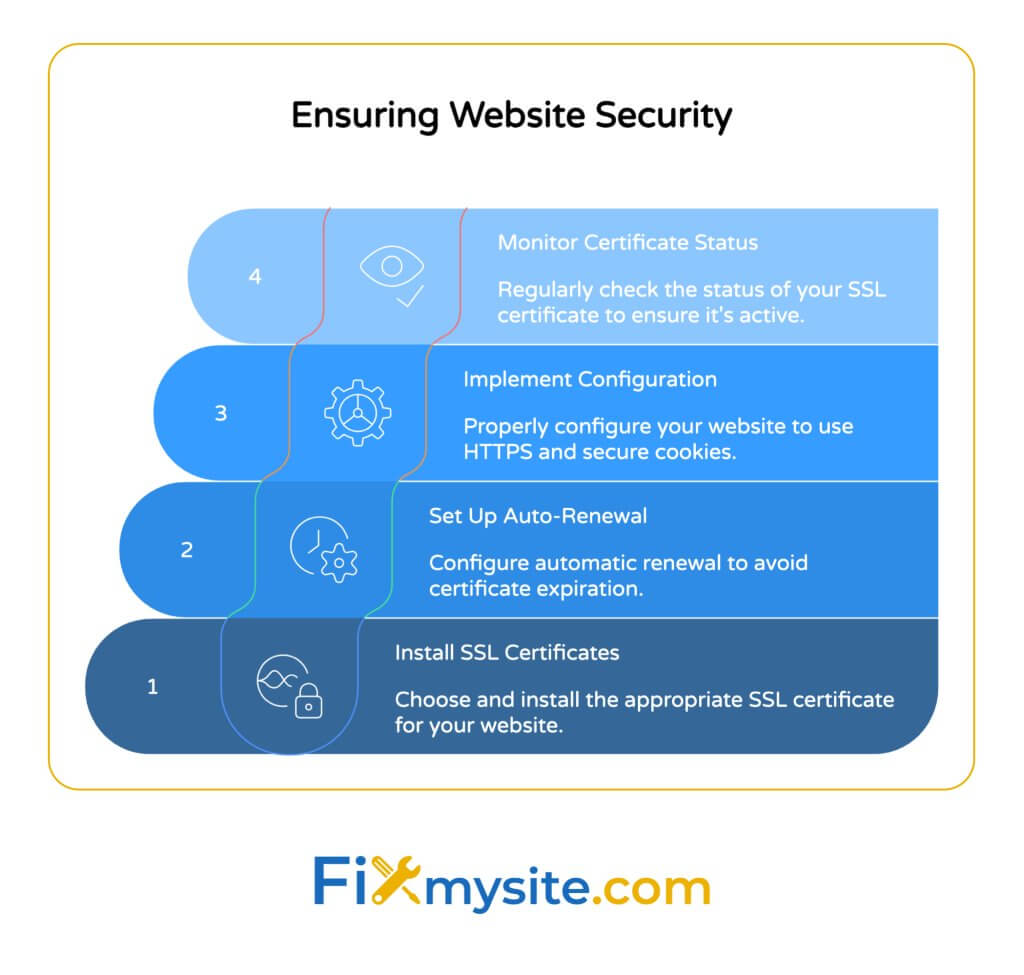
If you manage a WordPress site, these measures are especially important. Security certificates directly impact visitor confidence. They affect both user experience and search engine rankings. Prevention beats troubleshooting every time.
Install Valid SSL Certificates
Every website needs a valid SSL certificate. These digital credentials enable secure connections. They prevent “Your Connection is Not Private” errors. Choose certificates from trusted providers.
SSL certificates come in several types. Each offers different validation levels and features. Consider your site’s needs when selecting a certificate. E-commerce sites need higher security than informational pages.
| Certificate Type | Validation Level | Best For | Typical Cost |
|---|---|---|---|
| Domain Validation (DV) | Basic | Blogs, informational sites | $0-$50/year |
| Organization Validation (OV) | Medium | Business websites, organizations | $50-$150/year |
| Extended Validation (EV) | Highest | E-commerce, financial sites | $150-$300+/year |
| Wildcard Certificate | Varies | Sites with multiple subdomains | $100-$500+/year |
Many hosting providers offer free SSL certificates through Let’s Encrypt. These certificates provide basic security suitable for most websites. They require renewal every 90 days. Many hosts handle this automatically.
Set Up Automatic SSL Renewal
Certificate expiration causes most privacy errors. Automatic renewal prevents this problem. It ensures continuous certificate validity. Set reminders if automatic renewal isn’t available.
Most modern hosting platforms offer automatic SSL renewal. Check your hosting control panel for this feature. Enable it if available. This prevents future certificate-related errors.
For manually managed certificates, create calendar reminders. Set alerts 30, 14, and 7 days before expiration. This provides ample time to renew before visitors see warnings. Proper planning prevents emergencies.
Implement Proper SSL Configuration
Certificate installation is just the beginning. Proper configuration ensures everything works correctly. Common misconfigurations cause privacy errors despite valid certificates. Attention to detail matters.
Essential configuration elements include:
- Redirect HTTP to HTTPS: Ensure all traffic uses secure connections
- Update internal links: Change all site links from HTTP to HTTPS
- Fix mixed content: Ensure all resources (images, scripts) load via HTTPS
- Configure secure cookies: Set secure flag on all cookies
- Implement HSTS: Tell browsers to always use HTTPS for your site
For WordPress sites, plugins like Really Simple SSL help with proper configuration. They automatically handle most technical details. This simplifies secure implementation. The plugin addresses common SSL issues automatically.
Monitor Certificate Status
Regular monitoring prevents certificate problems. Several tools check certificate status automatically. They alert you before issues affect visitors. Proactive monitoring prevents reputation damage.
Key monitoring practices include:
- Set up uptime monitoring with SSL checks
- Verify certificate from multiple global locations
- Test certificate installation with online tools
- Configure alerts for approaching expiration dates
- Periodically check certificate details manually
Services like Uptime Robot, SSL Shopper, and Sucuri offer certificate monitoring. Many include free basic plans. These services provide peace of mind. They catch problems before your visitors do.
The concept of secure connections being fundamental to website functionality applies to both visitors and administrators. Regular security checks prevent most issues.
When to Proceed Anyway (and When Not To)
Sometimes proceeding past the warning is acceptable. Other times it’s dangerous. Understanding the difference keeps you safe. Context matters when deciding how to respond.
Proceeding past the warning risks exposing sensitive data if the site is compromised. (Source: MalCare) This risk varies based on the website and your activity. Consider these factors carefully.
Legitimate Scenarios to Proceed Safely
Some situations present minimal risk. Known, trusted websites with temporary certificate issues are generally safe. Local development environments often use self-signed certificates. These scenarios usually allow safe continuation.
Consider proceeding with caution when:
- The site is one you’ve used safely for years
- You’re on a corporate network with managed security
- You’re accessing a local development environment
- The site doesn’t request personal or financial information
- You’ve verified the certificate issue with the site owner
Even when proceeding, avoid entering passwords or financial information. Treat the session as potentially compromised. Limit your activity to browsing public information. This minimizes potential risk.
High-Risk Situations to Never Ignore Warnings
Certain scenarios present significant danger. Financial sites, online stores, and login pages should always have valid certificates. Proceeding on these sites risks data theft. The potential consequences outweigh any convenience.
Warning signs that you should never ignore:
| Warning Sign | Potential Risk | Recommended Action |
|---|---|---|
| Banking or financial website | Financial theft, account compromise | Contact the institution through official channels |
| E-commerce checkout page | Credit card theft, identity theft | Find alternative retailer or contact customer service |
| Login form with privacy warning | Password theft, account compromise | Verify site through alternative means before logging in |
| Multiple security warnings together | Sophisticated attack attempt | Close the site immediately |
| Unexpected certificate changes | Man-in-the-middle attack | Report to site owner, avoid the site temporarily |
If you see these warnings on sites handling sensitive information, stop immediately. Contact the company through official channels like phone support. Verify the site’s status before proceeding. Your financial safety takes priority.
Alternative Actions When You Can’t Proceed
When continuing isn’t safe, you have alternatives. Most services offer multiple access methods. These options maintain security while accomplishing your task. Safety doesn’t have to mean inconvenience.
Consider these alternatives:
- Use the company’s official mobile app instead of the website
- Call customer service for phone-based service
- Visit a physical location if available
- Use a different browser or device to access the site
- Try again later when certificate issues might be resolved
If you’re experiencing other WordPress errors like Critical Error messages, these might also be related to security configurations. Address all security issues promptly for best site performance.
With proper security measures being essential for all WordPress sites, addressing connection privacy errors promptly is critical. Don’t ignore these warnings on your own site—they drive visitors away.
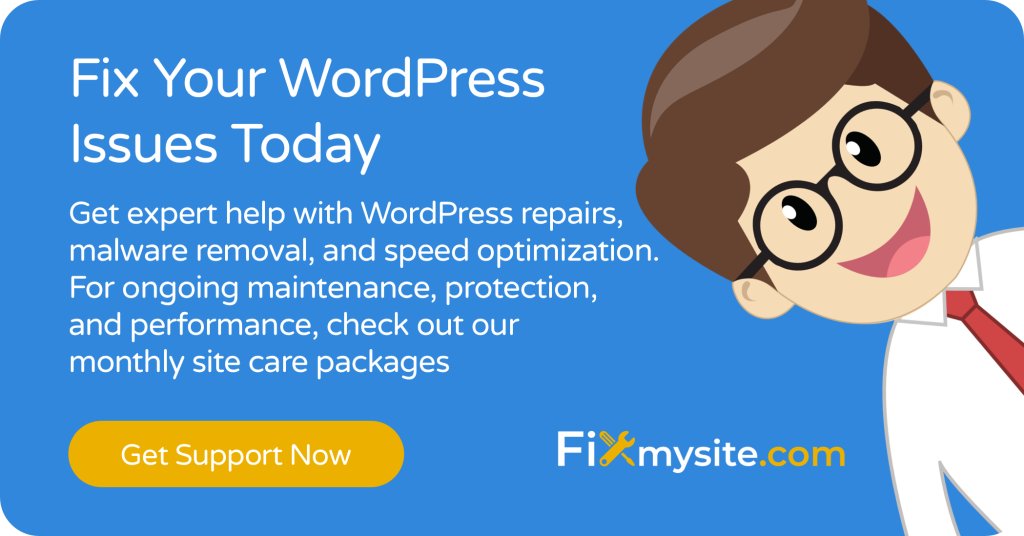
Conclusion
The “Your Connection is Not Private” error protects your online safety. Understanding its causes leads to effective solutions. Most fixes are simple and quick. They restore secure browsing quickly.
For website visitors, trying the troubleshooting steps in order solves most issues. Start with simple refreshes and work through more advanced solutions. Most errors resolve with basic steps. Stay patient during the process.
For website owners, prevention works best. Install and maintain valid SSL certificates. Configure them properly across your entire site. Monitor certificate status regularly. These practices keep visitors happy and secure.
What security best practices can prevent most WordPress errors including privacy connection warnings? Regular maintenance and proper security configuration prevent most issues. Don’t wait for errors to appear.
If you need help securing your WordPress site or fixing persistent SSL issues, our team at Fixmysite.com can help. We provide expert WordPress support for all security and configuration needs. Your website’s security is our priority.


